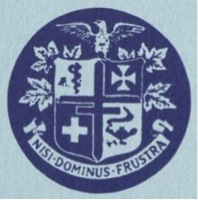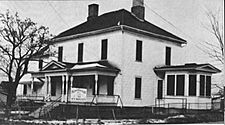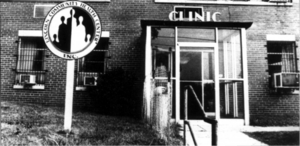Lincoln Hospital (Durham, North Carolina) facts for kids
Quick facts for kids Lincoln Hospital |
|
|---|---|
 |
|

A photograph of a wooden frame house in 1901, Logo: if not the Lord, [it is] in vain.
|
|
| Geography | |
| Location | Durham, North Carolina, United States |
| Coordinates | 35°59′26″N 78°54′49″W / 35.9906°N 78.9136°W (approximate) |
| Organization | |
| Hospital type | General hospital for African Americans |
| Affiliated university | Lincoln Hospital School of Nursing, Howard University, North Carolina Central University |
| Services | |
| Beds | 123 |
| History | |
| Closed | 1976 |
Lincoln Hospital was a special hospital in Durham, North Carolina, that helped African Americans from 1901 to 1976. The Duke family helped pay for its first building. It was the main hospital for African Americans in Durham until it closed in 1976. Its patient services then moved to Durham County General Hospital.
Even though it was built during a time called Jim Crow, when Black and white people were kept separate, Lincoln Hospital grew strong. This happened because Black and white people worked together. Doctors and nurses at Lincoln Hospital worked hard to make people healthier. They focused on helping moms and babies, fighting diseases, and teaching people how to stay well. The hospital also gave Black people chances to learn and work in healthcare, like nursing and surgery, when there weren't many other options.
Contents
History
Why Lincoln Hospital Was Needed
In the early 1900s, Black people in Durham faced many health problems. Their homes often lacked good heating and fresh air. They also had poor diets and worked very hard. This led to illnesses like malnutrition and infections such as tuberculosis and pneumonia.
Durham's factories, making tobacco and textiles, also spread diseases. In 1910, the death rate for Black people in Durham was much higher than for white people. Many believed Black people were naturally weaker, so some white people didn't care about these health differences. The separation of Black and white communities made these health gaps even wider.
How the Hospital Started
Even with segregation, a strong Black business community grew in Durham. This included places like "Black Wall Street" and companies like North Carolina Mutual Life Insurance Company. Leaders from these businesses, like Aaron McDuffie Moore, Stanford Lee Warren, and John Merrick, worked well with both Black and white communities.
They saw the big health differences in Durham. So, they asked wealthy white people for help to build a hospital for Black people. They convinced the Duke family (Washington Duke) to fund Lincoln Hospital. They said a hospital for Black people would help everyone in Durham. Dr. Aaron McDuffie Moore, Durham's first Black doctor, explained that Black and white people worked closely together. He said that if Black people were sick, it could also affect the health of white people.
Ben and James Duke gave $8,550 to build the hospital in Hayti, a Black neighborhood. The Duke family continued to support the hospital until it closed.
Community Support
Leaders at Lincoln Hospital said it showed what a community could do when both races worked together. At first, white people mainly helped with money. But over time, they became more involved in running the hospital. For example, Dr. Max Schiebel, a white doctor, joined the surgery team in 1944.
The hospital received help from private groups, individuals, and local governments. A special board of 21 members helped guide the hospital. One-third of the board members were white, and the rest were Black leaders from Durham. Women from both Black and white communities also helped. They collected linens, furniture, and other supplies for the hospital and the nurses' home.
Lincoln Hospital wanted to care for everyone, even if they couldn't pay. In 1938, two-thirds of its patients received free care. Many people in Durham called it "our hospital," showing how much they cared about it.
Hospital Buildings
The first hospital building was made of wood and could hold up to 50 patients. A fire damaged it in 1924. More money was raised, which helped build a new, bigger hospital. This new brick building opened on January 15, 1925. A Nurses Home was also added in 1924, given by B.N. Duke to honor his son.
Medical Services
Lincoln Hospital offered excellent care with some of the best Black doctors on the East Coast. It had departments for general medicine, gynecology (women's health), obstetrics (childbirth), and surgery. The medical departments changed over time to fit the doctors' skills and the community's needs.
Radiology and Lab Services
Doctors from Duke and Watts hospitals helped Lincoln with lab tests and radiology (X-rays). Margaret Kennedy Goodwin was a key person here. She was the head radiology technician from 1938 to 1976. She was the first African American woman to join a national group for radiology technicians. She also started a two-year training program for lab and radiology technicians in 1950.
Helping Moms and Babies
The hospital worked to help more women give birth safely in the hospital. They also taught new mothers about health and followed up with them after birth. This helped reduce deaths for mothers and babies. In 1910, many babies died, and many mothers died at home during childbirth. Education helped more Black women in Durham choose to have their babies at the hospital.
Children's Health
Lincoln Hospital also helped reduce child deaths through its Well Baby Clinic. Black mothers were encouraged to bring their children for check-ups. This made sure babies were growing well. Mothers also learned about proper diets and feeding times. All babies at the clinic received immunizations (shots to prevent diseases). By 1963, the rate of infection among Black children in Durham was lower than among white children.
The hospital also had special programs like the Crippled Children's Clinic. This was a joint effort with Duke Hospital's orthopedic (bone and joint) department. By 1937, the infant death rate in Durham County had greatly decreased for both Black and white babies.
Surgery Department
The surgery department at Lincoln Hospital offered full surgical services to African Americans. These services were not available at other nearby hospitals. Dr. Max Schiebel, who was Chief of Surgery from 1944 to 1971, greatly improved the program. He raised standards and brought his surgical skills to the hospital.
Dr. Charles DeWitt Watts (1917-2004) was Chief of Surgery in the 1950s and 1960s. He started a training program for doctors from Howard University. These doctors would come through Duke University Medical School, but because Duke was segregated, they received their training at Lincoln Hospital.
Later Years
After the Great Depression, Lincoln Hospital became one of the best hospitals for both Black and white people in the Carolinas. However, by 1950, people in Durham felt that both Lincoln and Watts hospitals needed updates. They asked for money to expand both hospitals. A local vote approved funds for a new wing, which was finished in 1953. This increased Lincoln's bed count to 123.
Like many Black institutions, Lincoln Hospital saw changes after integration. By the 1960s, both Lincoln and Watts Hospitals were providing older medical services. In 1965, Lincoln Hospital integrated its medical staff, meaning white and Black doctors could work together. However, patients of both races started going to other hospitals more often.
Charles DeWitt Watts founded the Lincoln Community Health Center (LCHC) in 1971. The health center and hospital worked together until September 25, 1976. On that day, all patients were moved to Durham County General Hospital. Today, the Lincoln Community Health Center offers many health services. These include adult medicine, pediatrics, dental care, and mental health services. It continues to help the community by working to reduce health differences and make sure everyone has access to care.
Images for kids








